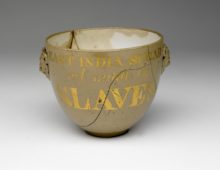Tagged with Textiles
Resource : The Rajah Quilt
Transportation was an extremely harsh punishment of the 1700s and 1800s, second only to execution. Between 1787 and 1852 as many as 25,000 women were transported from Britain to Australia to work in penal colonies, for crimes as varied as petty theft and poaching, to murder. Their sentences were often miscarriages of justice. Many didn’t survive the long journey. Most of them never returned. This remarkable quilt was made by women transported to Tasmania in 1841.
Resource : Cotton kerchief (headwrap)
The headwrap originated in sub-Saharan Africa. For centuries, it has been worn by women in different African countries and regions, in different forms, to reflect both communal and personal identities – which clan or tribe they belonged to, whether they were married, widowed, young or old, for example. This cotton kerchief, or headwrap, belonged to Nancy Burns (1800 – 1849). Born in Albany, New York, the daughter of slaves, she would eventually find work as a house servant and was painted in a portrait wearing the item in the 1840s. It represents a long history of cultural identity associated with women of African origin – particularly African-American women – that is still very much alive today.
Resource : The factory child’s trouble – sampler
This is a sampler that records the sufferings of a child, working in one of the many textile mills in Salford (Greater Manchester). It was sewn by Elizabeth Hodgates who was 12 years old in 1833 and reminds us of the terrible working conditions for children, women and men during the industrial revolution.
Resource : Laffayette orange peel quilt
Quilting has a long history in North America, dating back to the early colonial settlers of the 1600s and bringing together different ethnic and cultural traditions. As well as their practical use for warmth, they were made – often communally – to mark important family occasions such as weddings and births. As quilt-making developed from a practical necessity into skilled folk artistry, different patterns and symbols emerged carrying different meanings. This classic ‘orange peel’ design is said to have been influenced by Lafayette.
Resource : Figures by Chelsea Waterworks, London, observing the fires of the Gordon Riots, 7 June 1780
The Gordon Riots were a series of anti-Catholic protests which took place in London between 2 and 9 June, 1780. The protests began peacefully but descended into chaos. Crowds paralysed the city with an unparalleled level of violence, with rioters attacking and setting fire to official buildings and people’s homes. The riots are considered by some historians as being the closest Britain has ever come to a full-scale revolution, and shocked fellow European powers.
Resource : Textile sample books
Cotton was one of the latest textile fibres to be introduced to Britain as a raw material within a manufacturing system, but between the eighteenth and nineteenth centuries it rose to prominence as a cornerstone of the British economy. Cotton manufacture stimulated industrialisation, global commercial influence, and new communities of labour. This is one of five early sample books illustrating the cotton and calico designs produced by the textile industry in Salford between 1769 and 1851.
Resource : Martha Washington Doll
Martha Washington was the first ‘First Lady’ of the USA. Although the term ‘First Lady’ was not introduced until much later, Martha Washington was known as ‘Lady Washington’, in recognition of her status as the wife of the USA’s first President, George Washington.
Resource : Jacquard Loom
Before the 1800s, complex woven designs were created by hand. This was very labour-intensive. As a result, patterned fabric was extremely expensive. In 1804 Joseph-Marie Jacquard (1752 – 1834) developed the Jacquard Loom, which mechanised the production of patterned textiles. The loom contributed to the transformation of textile weaving from a ‘cottage industry’ run by close-knit families of skilled workers, to a focus of mass production on an industrial scale.


